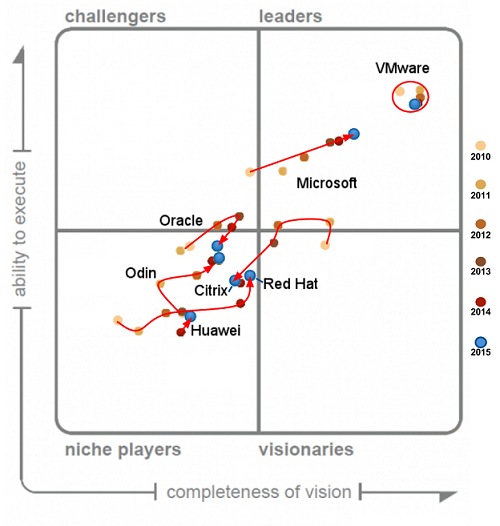Hypervisor wars: To be continued
Hypervisor wars are a continuous affair, and it's probably better to be a hypervisor agnostic. Nevertheless, it is possible to speak on this topic for a long time, which was the reason for the appearance of this article. For those who understand virtualization, there will not be a special revelation that the two largest players are VMware and Microsoft (

Undoubtedly, the leading company in the market is VMware. Taking up this position was not
The conventional wisdom is that VMware is the only option for large virtualization systems, and
Last year, an updated version of vSphere was released, and the
So, let's compare two hypervisors.
')
Round 1: The Easier, the Better
The basic VMware hypervisor - ESXi is the most lightweight option, the so-called “

Since the sixth version, the volume of the hypervisor has been reduced to 150 MB. In contrast,
This round by the number of points definitely wins the company VMware.
Round 2: The Harder The Better
As noted earlier, for a fairly long time, the VMware product was the No. 1 choice for corporations and large companies. Now here is
In terms of scalability, VMware supports up to 64 nodes in a cluster of updated vSphere, which is twice the performance of the previous version. One host can now accommodate up to 1,000 virtual machines, up to 480 physical processors and up to 12 TB of RAM. Compare -

It also provides access to some features that are considered more advanced than what
Although Esxi is a hypervisor for large objects, it is only slightly inferior in this hand-to-hand combat.

Round 3: The best things in life are free (at least almost)
One of the most significant advantages of
On the one hand, a Windows Server 2012 license allows you to run two virtual entities, and Windows Server 2012 Datacenter is released with an unlimited number of virtual entities on a single machine. If you intend to invest in Windows, then yes, it’s really free. Well, almost free.
In reality, in order to effectively manage multiple
Thus, it is not entirely clear which product is cheaper, it all depends on the specific circumstances. Sufficiently large organizations using Microsoft technologies may still have to run System Center 2012, regardless of the way they use the hypervisor for virtualization. Smaller organizations are likely to autonomously use
Round 4: Ready Queue
This little problem is becoming more and more common, and it is unique to Esxi. The reason many people don’t want is to virtualize individual applications at a cost that virtualization adds to any server. This is an additional level of management for
In a nutshell, this is the time during which the virtual machine must be ready to start before it is scheduled by the processor scheduler.
In principle, the more virtual machines (in terms of processor cores), the more chances for Ready Queue. This problem primarily concerns those who mistakenly believe that a large virtual machine has greater performance.
While this is true in the physical server world, in VMware virtual infrastructure, this leads to performance problems that are difficult to identify and even harder to fix. Not to say that
So who is the winner?
It all depends on the specific circumstances. The truth is that in terms of capabilities, both hypervisors are strong enough. Both parts of the equation are balanced by those who have used Microsoft products for many years, and by an army of VMware supporters and followers.
Let's see if the current situation will change the
Source: https://habr.com/ru/post/310002/
All Articles